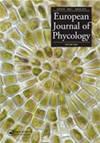波兰泰特拉山胸鳞亚纲(腕足亚纲,腕足亚纲)的进化及已分类澄清的奇莫诺齐亚纲(Chimonodinium lomnickii var. wierzejskii)的返祖现象
IF 1.7
4区 生物学
Q2 MARINE & FRESHWATER BIOLOGY
引用次数: 1
摘要
摘要目前,人们对钙质恐龙及其亲缘植物的特征进化知之甚少,尤其是在上皮的转化方面。lomnickii变种Chimonodinium wierzejskii的确切分类身份尚不清楚,但已经报道了两种不同的上皮板模式排列。我们研究了中欧各地收集的恐龙植物材料,包括Peridinium wierzejskii(波兰Tatra)和Peridinium lomnickii var.punctulatum(柏林)的模式区,并详细研究了8个单克隆菌株的形态。我们进一步获得了这些菌株的rRNA序列,包括27个新的GenBank条目,用于使用胸磷虾科代表性分类单元样本进行分子系统发育研究。在Chimonodinium中可以区分出五种ITS核糖类型,但其分布和形态分化似乎都与这些核糖类型无关。从系统发育树中推断出上皮的进化转变,在C.lomnickii var.wierzejskii中发现的主要板状模式是衍生特征状态的例证。然而,C.lomnickii var.wierzejskii罕见的上皮板模式代表了今天在Peridinium和Scrippiella中发现的祖先特征状态。这是返祖现象的一个迹象,在微生物领域只知道极少数的病例。威氏Peridinium wierzejskii的名称通过表位分类进行了分类澄清。亮点•微生物领域返祖现象的罕见文献•从类型定位建立菌株的深层形态•从级联rRNA序列数据推断的分子系统发育学本文章由计算机程序翻译,如有差异,请以英文原文为准。
Evolution of Thoracosphaeroideae (Peridiniales, Dinophyceae) and a case of atavism in taxonomically clarified Chimonodinium lomnickii var. wierzejskii from the Polish Tatra Mountains
ABSTRACT Character evolution in calcareous dinophytes and their relatives is poorly understood at present, particularly regarding the transformations of the epitheca. The precise taxonomic identity of Chimonodinium lomnickii var. (≡ Peridinium) wierzejskii is unclear, but two different arrangements of the epithecal plate pattern have been reported. We studied dinophyte material collected across Central Europe, including the type localities of Peridinium wierzejskii (Polish Tatra) and Peridinium lomnickii var. punctulatum (Berlin), and investigated the morphology of eight monoclonal strains in detail. We further obtained rRNA sequences of the strains, including 27 new GenBank entries, for a molecular phylogenetic study using a representative taxon sample of the Thoracosphaeroideae. Five ITS ribotypes could be distinguished in Chimonodinium, but neither the distribution nor morphological differentiation seems to correlate with these ribotypes. An evolutionary transformation of the epitheca is inferred from the phylogenetic tree, with the predominant plate pattern found in C. lomnickii var. wierzejskii exemplifying the derived character state. However, the rare epithecal plate pattern of C. lomnickii var. wierzejskii represents the ancestral character state today found in, for example, Peridinium and Scrippsiella. This is an indication of an atavism, of which only very few cases are known from the microbial domain. The name Peridinium wierzejskii is taxonomically clarified by epitypification. HIGHLIGHTS • Rare documentation of atavism in the microbial domain• Deep morphology of strain established from type locality• Molecular phylogenetics inferred from concatenated rRNA sequence data
求助全文
通过发布文献求助,成功后即可免费获取论文全文。
去求助
来源期刊

European Journal of Phycology
生物-海洋与淡水生物学
CiteScore
4.80
自引率
4.20%
发文量
37
审稿时长
>12 weeks
期刊介绍:
The European Journal of Phycology is an important focus for the activities of algal researchers all over the world. The Editors-in-Chief are assisted by an international team of Associate Editors who are experts in the following fields: macroalgal ecology, microalgal ecology, physiology and biochemistry, cell biology, molecular biology, macroalgal and microalgal systematics, applied phycology and biotechnology. The European Journal of Phycology publishes papers on all aspects of algae, including cyanobacteria. Articles may be in the form of primary research papers and reviews of topical subjects.
The journal publishes high quality research and is well cited, with a consistently good Impact Factor.
 求助内容:
求助内容: 应助结果提醒方式:
应助结果提醒方式:


